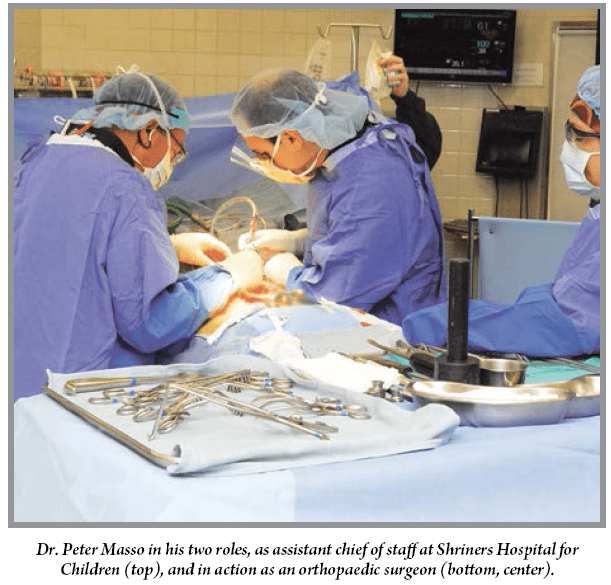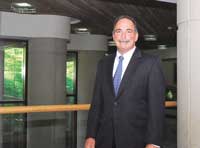Back to the Future – Shriners Hospital’s Masso Stays Ahead of the Curve in Orthopaedics
As the assistant chief of staff at Shriners Hospital for Children in Springfield and a veteran orthopaedic surgeon, Dr. Peter Donald Masso never imagined making the leap into spinal correction when he graduated from the University of Connecticut School of Pharmacy in 1980 with his bachelor’s degree.
Initially working as a pharmacist after finishing school, it wasn’t long before he found his true calling was not working behind the counter of a pharmacy, but rather at a surgical table.
“I never thought I’d end up in orthopaedics because of my background in pharmacy,” Masso explained. “I had a lot of knowledge in treating diseases with medication, but after working as a pharmacist for a year, I really started to notice the difference between surgery and medicine.”
“For me, it was a matter of being able to take a problem and fix it immediately rather than via long-term treatment with medication that’s more prolonged with varying results,” he went on. “That’s what drove me to orthopaedics.”
With that desire to make a difference more directly for those in need of care, Masso returned to UConn to gain his M.D. He completed his surgical residency at Hartford Hospital and orthopaedic residency at the university’s School of Medicine by 1990, and an orthopaedic fellowship at Vanderbilt University the year after that.

It was as he continued to develop his practice as a spinal surgeon that Masso began to focus more and more on pediatrics. It was a perfect move, the doctor said, because the earlier a spinal deformity or condition is detected in a child, the greater the impact of its treatment, especially when it comes to scoliosis.
“I really gravitated toward taking care of children with spinal deformities, and that primarily ends up being scoliosis among other conditions like kyphosis,” he said. “That’s my most common operation, taking care of those kids.”
A deformity in which the spine forms a lateral curve that, based on severity, can cause large amounts of pain, prevent physical activity, and put pressure on vital organs, scoliosis is often linked to congenital problems or neuromuscular disease (such as cerebral palsy) as causes, but is most commonly idiopathic, caused by no underlying reason.
With one in 100 people believed to have some form of scoliosis, the sideways curving is common, but with only three per 1,000 requiring treatment, the deformity, along with a number of other spinal conditions, requires the kind of care and facilities found at a specialty orthopaedic hospital like Shriners, where Masso has personally witnessed the brand of medicine evolve.
Spinal Care and Surgery
Working with Shriners Hospital in Springfield for 23 years while contributing to a number of research papers focusing on juvenile-onset scoliosis and the effects of multi-level surgery on those with cerebral palsy, Masso has seen first-hand a number of advancements made in orthopaedic care.
When the pediatric surgeon first entered the field, neuromuscular imaging technology was virtually nonexistent. Only shortly after he began, MRIs and other imaging techniques started to emerge, bringing with them low-quality scans of limited parts of the spine.
But with major improvements not only in body scanning but also in the processing power of the computers themselves over the past decade, monitoring the human spine has never been more safe or detailed.
“It was nonexistent when I first started practicing, and eventually, you could only monitor the activity found in the posterior aspect [outer side] of the spinal cord. Now, though, we can measure the anterior [deeper, inner] part of the spinal cord with these new techniques, which is very important for a more accurate read of sensory activity,” he told HCN.
“There’s been a great deal of improvement in the type of hardware in the devices that we use, giving us more stable fixation, allowing us to get better correction, and we’re able to do that more safely with other techniques that have been developed,” he went on. “For example, better neuromonitoring gives us a better idea of when the spinal cord has been put under too much stress during a procedure, and we have to reverse what we’re doing; the monitors give us more immediate feedback for those situations.”
Among other improvements in the operating room, such as the use of anesthesia and blood monitoring that have made spinal surgery safer than it ever has been before, one of the most technologically advanced departments of the Springfield hospital’s orthopaedic care comes from Shriners’ Motion Analysis Laboratory.
Found in a small auditorium on the second floor of the hospital, the laboratory is equipped with infrared cameras on the ceiling and several more on ground level, a host of computers installed to collect and process data, and monitoring equipment ranging from markers for the infrared cameras to full, three-dimensional body scanners.
Epitomizing a new era of orthopaedic technology, the lab allows for a patient to walk down a mat in the center of the room and, with the multiple ball-like markers attached to his or her legs and back sending data to the infrared cameras, have their gait, leg control, and leg-muscle activity recorded and assessed, among other essential functions.
Complete with a 3D image of a patient provided by the lab’s body scanner, real-time animation of their walk cycle from multiple angles allows for more accurate reports and effective treatment plans. It’s the type of technology that’s helped keep Shriners Hospital for Children a major player in the field of orthopaedics.
In fact, othopaedic care has been at the core of Shriners hospitals since their inception in 1920, with the network’s very first hospital in Shreveport, La. opening in 1922. Originally called Shriners Hospital for Crippled Children, the facility focused on pediatric orthopaedics at a time when polio still ran rampant and children were in need of focused, specialty care.
In the years to come, the hospital network began branching out into other specialties, including spinal-cord injuries, burn care, and treatment of cleft-lip and palate conditions.
After close to a century of operation, Shriners has grown to 22 nonprofit hospitals across the continent with a mission statement of “providing the highest quality of care to children with neuromusculoskeletal conditions, burn injuries, and other special healthcare needs.” The focus on pediatrics and orthopaedics suits Masso very well.
“Shriners has built up an incredible system of hospitals. Primarily orthopaedic, there are also those that specialize in nerves and spinal-cord injuries, and they all have spectacular facilities,” he said. “Nearly all of them are associated with residency programs with a number of universities, and the unique nature of the work makes it a special place to get treated.
“Everyone I’ve been associated and worked with here has big hearts,” he went on. “They’re here for the kids. They give their time to help these kids, and though things have changed over time, such as healthcare systems and insurance practices, that’s never wavered.”
With its entranceway decorated with Lego statues and an outpatient lounge filled with activity stations and video games for children of all ages, the Springfield hospital delivers on its family-friendly values the minute patients enter the establishment.
And as a pediatric-only hospital, feedback from the parents on the environment and its services are especially taken to heart by the assistant chief of staff.
“We try to have an environment that’s as friendly and non-threatening from the second you walk in through the door,” Masso explained. “It’s family-centered care, so, while the children’s needs are taken care of, the parents’ needs are especially acknowledged.
“We’re incredibly attuned to our family and patient surveys and are always trying to improve whenever we can,” he continued, “whether a wait time was a little longer than expected or our services were temporarily tied up. But by and large, the vast majority of people love the facility.”
Winning Combination
For a concerned family trying to figure out what’s inhibiting their child’s walking or causing pain when they try to sit upright, the pairing of Shriners’ pediatrics expertise and Masso and his quality staff couldn’t be a better match.
The entire wing is filled with trained physical therapists working with the children, technicians ensuring the motion lab’s imaging is spot-on, and doctors analyzing the data the motion lab collects and processes less than three hours after testing concludes.
With June being Scoliosis Awareness Month, Masso and these orthopaedic professionals will see their field of medicine put in the spotlight for the public. And while the attention is appreciated and productive, for this doctor, it’s all about the patient he’s seeing next.
“What you do for the patient in front of you every day is the most important thing to me,” he said. “It’s not about the last paper you wrote; that doesn’t make a difference to them. When I go home every day, what matters most to me is whether I helped somebody and to what degree, and what challenges I have ahead of me.
“It’s always about doing your best for your patient in front of you; nothing makes more of a difference,” he went on. “Nothing is more important.”


Comments are closed.